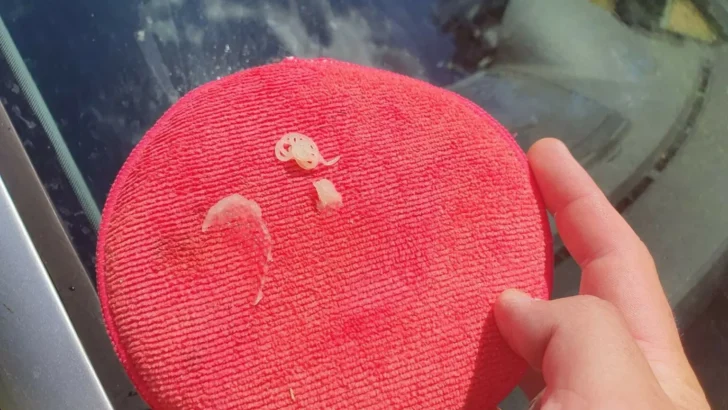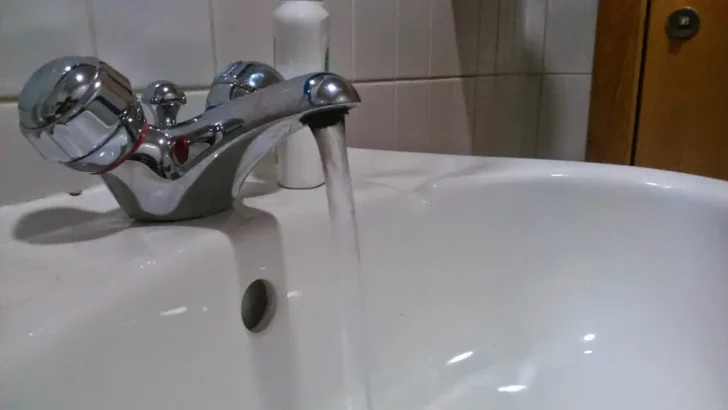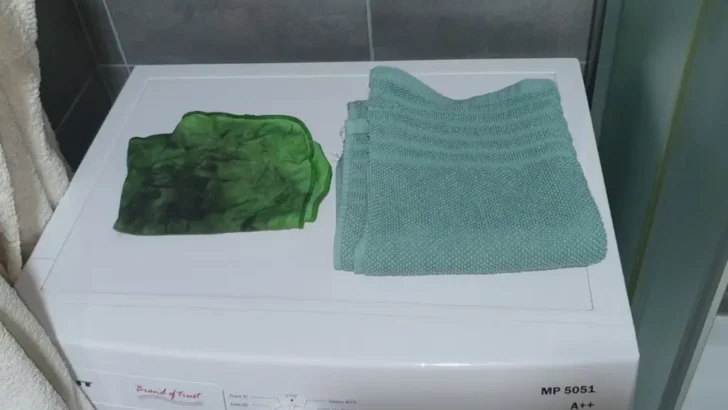If you’re like most people, you probably don’t think about wax applicator pads until they become dirty. And by that time, it’s too late – the wax is caked on and it’s a pain to clean.
In this blog post, we will walk you through the step-by-step process of how to clean car wax applicator pads. It’s actually very easy to do, and only takes a few minutes!
Key Takeaway
- To clean a car wax applicator pad you need to run it under lukewarm water, apply an all-purpose cleaner or a dish soap and then work it in. If your wax applicator pads are hardened, you can use a brush to scrub them. Rinse the pads and place them on a clean microfiber towel to dry.
What Are Car Wax Applicator Pads?
Car wax applicator pads are tools used in the process of applying wax to a vehicle’s surface.
They are typically made from soft, absorbent materials such as foam or microfiber, which are gentle on the car’s paintwork.
The pads are designed to hold the wax and distribute it evenly across the vehicle’s surface, ensuring a smooth and consistent application.
This helps to maximize the protective and aesthetic benefits of the wax. Some applicator pads may also feature handles or pockets for ease of use.
It’s important to clean them properly after use to maintain their effectiveness and prolong their lifespan.
How To Clean Car Wax Applicator Pads

- Run the pad under warm water
- Apply all-purpose cleaner or dishwasher soap
- Work in the all-purpose cleaner
- Rinse the wax pad
- Place the clean wax pad on a clean microfiber towel
Keeping your car wax applicator pads clean is essential if you want to achieve the perfect finish with your wax. When you’re done doing compounding and polishing on your paint (paint correction), there’s a lot of gunk and a lot of polishing compound that’s left in your pads.
If you want to keep them effective, of course, in between passes you’re going to clean your pads using either compressed air a foam pad, or a microfiber pad conditioning brush.
But how do you actually clean the car wax applicator pads after the job is completely done? Here is how to clean your car wax applicator pads:
Required items
- Pad brush (or any soft bristle brush)
- An all-purpose cleaner (or simply a dishwasher soap)
- Microfiber towel
1. Run the pad under warm water

Regardless of what type of wax applicator pads you have (open or closed cell pad), the pad will expand when you run it under warm water. The temperature of the water should be tolerated by your hands, so don’t make it way too hot.
What the warm water actually does is it makes the pads more pliable. Plus, while doing this, you can push some of the polishing compound and clearcoat out without even using any chemicals.
2. Apply all-purpose cleaner or dishwasher soap

Once the wax applicator pads are nicely soaked from the previous step, it is time to add some chemicals. For this step, you can use an all-purpose cleaner, or simply a dishwasher soap. Either one of these will do the trick. Apply the cleaner/soap to the pad and move on to the next step.
Important note:
If you are trying to wash a pad that has been sitting for a very long time and is hardened, try this. There are a few different chemicals that can be used to clean old wax applicator pads, but the best one to use is alcohol. Alcohol will quickly and effectively break down the wax on the pad, making it easy to remove.
If you don’t have any alcohol on hand, you can also use vinegar or lemon juice. These acidic liquids will also break down the wax on the pad, though it may take a little longer than alcohol. Soak the pad in either vinegar or lemon juice for about 15 minutes and move on to the next step.
3. Work in the all-purpose cleaner
With an applied all-purpose cleaner or dishwasher soap onto the wax pads, massage the cleaner into the foam pad. The cells on the foam pad opened from the use of warm water a few seconds ago. Just work in the cleaning solution really nicely before rinsing it.
If your wax pads have been sitting for a long time and are all sturdy, you can use a padded brush to try and break down the hardened compound and wax. If you don’t have a brush designed just for cleaning pads, you can use a soft bristle brush. The idea here is to only remove the compound and leftover wax, not to tear the foam.
4. Rinse the wax pad
Rinse the wax pad with hot water that can be tolerated by your hands. The hot water will again open up the cells on the pads and will help release all that spent compound and polish.
The key here is to rinse it so well that there is no cleaner or dish soap left on the pad. This is important because you don’t want this kind of chemical on your car paint.
5. Place the clean wax pad on a clean microfiber towel
What I like to do when drying my applicator pads is to place them on a clean microfiber towel, face down. When you place the pad face down, all of the liquids travel through the foam and into the microfiber towel.
This way, you don’t have any liquid sticking to the top part of the pad where the glue is. If you don’t have a microfiber towel and want to use a dry rack, again, place it face down.
Once your wax applicator pad is clean and dry, be sure to store it in a cool, dry place. This will help extend its lifespan so that you can use it for many more waxing sessions. With proper care, your wax applicator pad should last for several months.
Can You Reuse Wax Applicator Pads?

Yes, you can reuse wax applicator pads. However, you need to make sure that you clean them after each use. Otherwise, the wax will build up on the pad and make it difficult to use.
Wax applicator pads are made of a soft, absorbent material that is designed to hold and distribute the wax evenly. They are often used in conjunction with a wax warmer or heater to melt the wax before application.
Once the wax is melted, the pad is then used to apply the wax to the desired area. Wax applicator pads can be found in most beauty supply stores or online retailers that sell hair removal products.
While there are many different brands and types of wax applicator pads available on the market, they all generally serve the same purpose. Choosing the right type of pad for your needs will largely depend on personal preference.
Some people prefer thicker pads that offer more coverage, while others prefer thinner pads that are easier to maneuver.
Wax applicator pads are typically made from one of two materials: foam or microfiber. Foam pads are generally less expensive and can be found in a variety of thicknesses. Microfiber pads are often more expensive, but they’re also more durable and tend to last longer.
If you’re using a disposable wax applicator pad, you can simply throw it away after each use. If you’re using a reusable wax applicator pad, be sure to wash it with soap and water after each use. Then, allow it to air dry before using it again.
Either way, you should always avoid using a dirty wax applicator pad on your skin. Waxing is already painful enough!
Can You Wash Car Wax Rags?

You can certainly wash car wax rags, but there are a few things to keep in mind. First, it’s important to use a mild detergent and warm water. You don’t want to use anything too harsh that could damage the fabric.
Second, make sure you rinse the rags well after washing them. You don’t want any soap residue left behind that could potentially harm your paint job.
Car wax rags are specifically designed to apply car waxes and polishes. They are usually made from a soft, absorbent material that will not scratch the paintwork on your car.
Many people use old t-shirts or microfiber cloths for this purpose, but these can actually damage your paintwork if they are not soft enough. Car wax rags are a much better option.
There are a few things to consider when choosing car wax rags. The first is the material. Cotton is often used, but it can leave lint behind on your paintwork. Microfiber is a good option as it is very soft and will not scratch your paintwork.
Finally, let the rags air dry completely before using them again. With these tips in mind, you should have no problem keeping your car wax rags clean and in good condition for years to come!
FAQs
Q: Why do I need to clean my car wax applicator pads?
A: Cleaning your car wax applicator pads is essential to maintain their effectiveness and prolong their lifespan. Over time, the pads accumulate residues from the wax, dirt, and other contaminants, which can hinder their performance and create a subpar finish.
Q: How often should I clean my car wax applicator pads?
A: It is recommended to clean your car wax applicator pads after every use. Regular cleaning helps prevent the buildup of wax residues and maintains the quality of the pads.
Q: How do I clean car wax applicator pads?
A: To clean car wax applicator pads, start by rinsing them with warm water to remove loose debris and wax residues. Then, apply a mild detergent or car shampoo to the pads and gently massage them to loosen any remaining wax. Rinse thoroughly until no soap residue is left and allow them to air-dry completely before storing.
Q: Can I machine wash car wax applicator pads?
A: It is generally not recommended to machine wash car wax applicator pads. The agitation and harsh detergents used in washing machines can damage the pads’ delicate fibers and affect their performance.
Q: Are there any special cleaning products for car wax applicator pads?
A: While there are specific cleaning products available for car wax applicator pads, you can also use a mild detergent or car shampoo for cleaning. Just ensure that the cleaning product you choose is gentle and does not contain any harsh chemicals that could damage the pads.
Q: Can I use bleach or fabric softener to clean car wax applicator pads?
A: No, you should not use bleach or fabric softener to clean car wax applicator pads. These products can be too harsh and cause damage to the pads’ fibers. Stick to using mild detergent or car shampoo instead.
Q: How long does it take for car wax applicator pads to dry after cleaning?
A: The drying time for car wax applicator pads can vary depending on various factors such as humidity and airflow. Generally, it is best to allow the pads to air-dry naturally, which can take anywhere from a few hours to overnight.
Q: Can I store car wax applicator pads when they are still damp?
A: It is not recommended to store car wax applicator pads when they are still damp. Moisture trapped in the pads can lead to the growth of mold or mildew, which can ruin the pads and affect their performance. Ensure the pads are completely dry before storing them.
In Conclusion
The pads can be hand washed using dish soap or all-purpose cleaner with warm water, ensuring to scrub away any residual wax or dirt.
It’s crucial to thoroughly rinse the pads and allow them to air dry to maintain their effectiveness.
